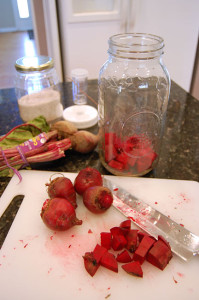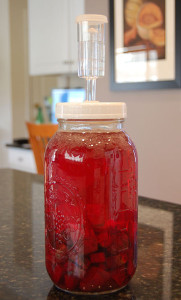Beets — four+ ways to use them.
Having been raised in a somewhat ethnic family (the “old country,” in this case, being Russia/Poland), I tend to be more open to trying– and usually liking–foods that most Americans would not even consider touching. Heart, liver, kidneys, trotters, blood puddings: my relatives had a real “waste no part of the animal mentality.” Nose to tail consumption. As I’ve always been slender and healthy, I figure I must be doing something right. I’ve also never met a vegetable I didn’t like. I’ll never starve to death, that’s for sure!
One vegetable that I enjoy, yet a lot of people will turn their noses up to, is the humble beet. Beets are typically a deep, rich ruby red in color, although you can also find orange and two-tone ones (alternating layers of red and white). Vegetables that have deep colors tend to be supersaturated with nutrients, antioxidants, minerals and vitamins.
I grow beets in the garden and have come to love the beet greens (tops) as well. Some people say that beets taste like dirt (maybe that’s why I like them, lol), but the tops, when sautéed, taste similar to spinach. Harvesting just a few leaves at a time from several plants throughout the summer and early fall will cause replacement leaves grow, thereby creating a sustainable situation. The leaves can also be added to salads, raw and chopped, therefore retaining their nutritional value.
Some of my favorite ways to use the beet roots is pickling (these can also be canned), roasted and cut into pieces for salads, grated raw into salads, fermented pickling, beet kvas and a cold or hot soup called borscht. Beets also have a natural earthy sweetness to them that pairs beautifully with salty/sour pickling and fermentation.
Pickled Beets
This makes a great cold side dish, especially with summer barbecues or added to a chopped salad. Food Network has a nice Alton Brown pickled beet recipe that calls for roasting the beets first, and then letting them soak in a seasoned brine mixture for up to 7 days before serving. I’ve tried this one and it’s a winner!
Old Fashioned Fermented Pickled Beets
I’ve tried the recipe in Nourishing Traditions, which calls for whey and it’s just “okay.” I prefer not using whey for fermentation, the results just don’t taste the same as natural fermentation. Here’s a good fermented beets recipe that calls for simply beets, salt and water. Personally, I would also add onions. And fermentation = probiotics!
Borscht
I’ve never actually made this soup, but I have had it a few times in both Russian and Jewish restaurants. In those instances the cold soup was puréed, served with a dollop of sour cream, and I couldn’t identify what was in it other than beets. Served in this way, the soup makes a nice appetizer (as opposed to a meal, which calls for a heartier recipe).
My search on the internet brought up a variety of recipes that include all sorts of ingredients, some with meat, some without. This Borscht recipe from Cooks.com has the best rating and comments from cooks. I am tempted to take the advice in one comment about using tomato paste, fried in butter, rather than canned tomatoes. Note: Try not to use canned anything, unless you have no other option! Fresh is best!
Beet Kvas
This is a fermented, naturally carbonated beverage made from only three ingredients: beets, filtered water and salt. The first time I made and tasted this I just knew it was a tonic for the blood. There’s something about the combination of salty-sour-carbonation that I crave at times. And Kvas practically makes itself.
Update: A week in the fridge and the little kvas I have left has turned a brownish red. But it still smells and tastes good, so keep that in mind.
Beet Kvas - no whey!
Ingredients
- 3-4 beets a generous medium size
- 1-1/2 quarts water filtered
- 1 TB sea salt (or a little more if you like)
- 1-2 cloves garlic Optional
Instructions
- Wash beet roots to remove any dirt but don't overdo it, you don't want to remove all the good (lactobacillus) bacteria.
- Chop into, roughly, 1" chunks.
- Add beets to a half gallon jar.
- Add 1 TB sea salt.
- Add filtered water to within 1/2" below lip.
- Cover with lid and write the date on the jar with a Sharpie.
- Allow to ferment, out of direct sunlight, for 1-1/2 weeks or more.
- When done, this can be strained, or just serve right out of the jar, chunks and all. Enjoy!




